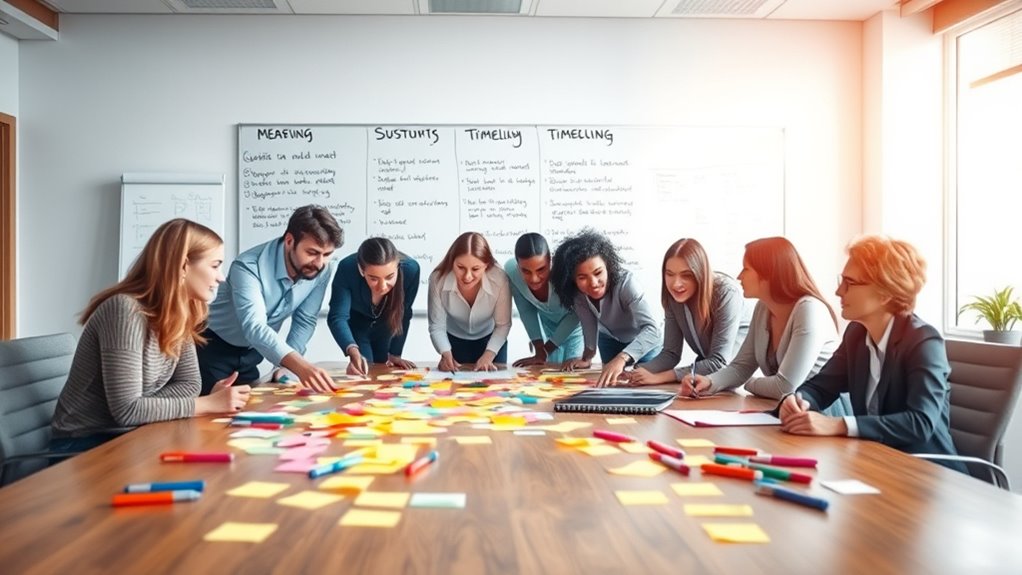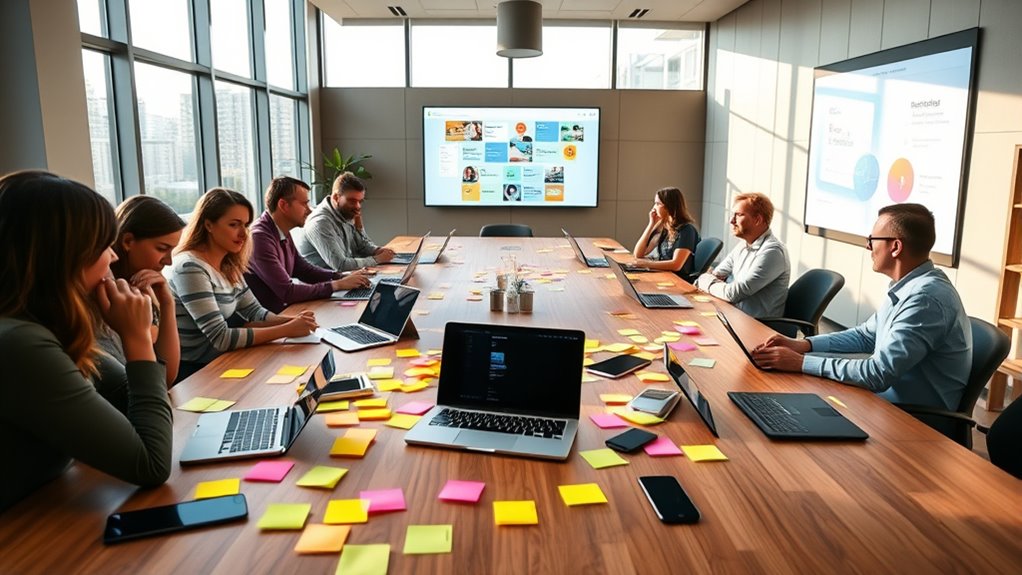After your workshop, keep the momentum alive by setting clear, achievable goals that align with your broader objectives. Create detailed follow-up plans with assigned responsibilities and schedule regular check-ins to track progress. Use digital tools to facilitate collaboration and celebrate small wins to boost motivation. Address challenges promptly and adapt strategies as needed. Continuing to refine your approach guarantees sustained momentum—exploring these steps further will help you stay on track long after the initial activity ends.
Key Takeaways
- Establish clear follow-up plans with defined roles, responsibilities, and accountability measures to maintain progress and momentum.
- Regularly schedule check-ins and reviews to monitor progress, address obstacles, and adapt strategies as needed.
- Use digital tools and interactive platforms to facilitate ongoing collaboration, idea sharing, and real-time updates.
- Celebrate small wins and milestones to boost morale, reinforce progress, and sustain motivation.
- Foster open communication and create a safe environment for feedback, problem-solving, and continuous improvement.
Setting Clear Post-Workshop Goals

After a workshop, setting clear goals helps you translate new knowledge into action. To stay motivated, incorporate motivational incentives that reward progress and keep you focused. Make sure your goals align with your broader objectives, ensuring each step moves you closer to your vision. Well-defined goals give you a roadmap, making it easier to prioritize tasks and measure success. Avoid vague intentions; instead, set specific, achievable targets that challenge yet motivate you. When your goals align with your values and incentives, you’ll find it easier to stay committed and avoid distractions. Clear post-workshop goals serve as a foundation, guiding your efforts and maintaining momentum long after the workshop ends. This focus turns insights into tangible results. Incorporating goal setting strategies can further enhance your ability to stay on track and sustain your progress over time.
Creating a Follow-Up Action Plan

To turn your workshop insights into lasting change, creating a follow-up action plan is essential. Start by identifying specific steps to implement your goals, ensuring each task is clear and actionable. Incorporate motivational incentives to keep your team engaged and committed, rewarding progress along the way. Use team building activities to strengthen collaboration and foster a sense of shared purpose. Regular check-ins help maintain momentum, allowing you to address obstacles promptly. A well-structured plan keeps everyone accountable and focused, preventing ideas from fading away. Additionally, emphasizing sustainable practices can help ensure that changes are maintained over the long term. Remember, a successful follow-up plan isn’t just about tasks; it’s about creating an environment where motivation and teamwork thrive, ensuring the workshop’s impact endures long after the dust settles.
Assigning Responsibilities and Ownership

To guarantee everyone knows their part, you need to clearly define roles and responsibilities. Setting accountability measures helps keep tasks on track and prevents confusion. When responsibilities are transparent, your team can work more efficiently and confidently. Incorporating assigned responsibilities ensures that each team member understands their specific duties and contributes effectively.
Clarify Roles Clearly
Have you ever wondered why projects stall or confusion arises within teams? The key often lies in unclear role clarification. When responsibilities aren’t clearly defined, team members may duplicate efforts or leave crucial tasks undone. To prevent this, focus on responsibility delineation—specifically assigning specific roles and ownership for each task. Make sure everyone knows what they’re accountable for and where their contributions fit into the bigger picture. Clear communication about roles eliminates ambiguity and helps team members work more efficiently. When responsibilities are explicit, accountability becomes natural, and the project moves forward smoothly. Take time to document and share these roles, so everyone understands their part and can confidently execute their responsibilities without confusion. Additionally, understanding the importance of role clarity can significantly boost team productivity and project success.
Establish Accountability Measures
Establishing accountability measures is essential for ensuring that responsibilities and ownership are clearly assigned and upheld throughout the project. To do this effectively, create clear expectations and track progress regularly. Incorporate motivational incentives to keep team members engaged and committed, reinforcing their sense of ownership. Form accountability partnerships where individuals or groups support each other in meeting goals, fostering a culture of shared responsibility. Clearly define who is responsible for each task and set deadlines to prevent ambiguity. Regular check-ins help maintain momentum and address issues early. Additionally, understanding home organization principles can aid in creating more effective accountability systems. By implementing these measures, you guarantee everyone stays motivated, accountable, and aligned, making it more likely that your project will sustain its progress long after the workshop ends.
Establishing Regular Check-Ins and Progress Reviews

Implementing regular check-ins and progress reviews keeps your team aligned and accountable. Motivational check-ins boost morale, reminding everyone of their goals and progress. These sessions also foster peer accountability, encouraging team members to support each other’s growth. By consistently reviewing progress, you identify obstacles early and adjust strategies as needed. Regular touchpoints prevent tasks from slipping through the cracks and keep momentum going after the workshop ends. Make these check-ins brief but focused, emphasizing honest feedback and celebrating small wins. When team members feel connected and responsible, motivation stays high, and accountability becomes a shared priority. Establishing a routine of these reviews ensures continuous improvement and long-term success beyond initial workshop enthusiasm. Additionally, tracking progress indicators helps measure success and guides future actions effectively.
Leveraging Digital Tools for Collaboration

Digital tools like cloud-based platforms and real-time document sharing make collaboration smoother and more efficient. You can easily coordinate with your team, no matter where everyone is located. Interactive digital workspaces further enhance engagement and streamline project workflows. Incorporating these tools into your routine can also help maintain a consistent home decor style throughout your projects.
Cloud-Based Collaboration Platforms
Cloud-based collaboration platforms have revolutionized the way teams work together by providing real-time access to shared documents, communication tools, and project management features. With these platforms, you can easily facilitate virtual icebreakers to build rapport at the start of meetings. They also support dynamic brainstorming sessions, where everyone can contribute ideas instantly, regardless of location. These tools streamline workflows, reduce email clutter, and keep everyone aligned. You can track progress, assign tasks, and share updates seamlessly, which helps sustain momentum after workshops. By leveraging digital collaboration platforms, you foster ongoing engagement and ensure that ideas generated during sessions are nurtured and acted upon efficiently. Incorporating analytical cookies can also help understand how team members interact with these tools, further enhancing productivity. This approach keeps your team connected, motivated, and focused on common goals.
Real-Time Document Sharing
Real-time document sharing transforms collaboration by allowing your team to edit, comment, and review files simultaneously, no matter where everyone is located. With real-time editing, changes appear instantly, reducing confusion and streamlining workflows. This immediate visibility encourages instant feedback, so issues are addressed promptly, and ideas evolve quickly. You no longer need to rely on email attachments or version control headaches—everyone works on the same document at once. As a result, collaboration becomes more dynamic and efficient, fostering a sense of shared ownership. Whether you’re brainstorming, refining a report, or updating project plans, real-time document sharing keeps everyone aligned and engaged, helping your team maintain momentum well beyond the initial workshop phase. Incorporating integration with collaboration tools enhances coordination and ensures seamless communication throughout your projects.
Interactive Digital Workspaces
Interactive digital workspaces harness the power of various tools to streamline team collaboration. They enable you to engage in virtual brainstorming sessions, where ideas flow freely regardless of location. These platforms combine chat, video, and shared documents, making it easy to capture insights in real-time. With digital brainstorming tools, you can organize ideas visually, prioritize tasks, and track progress seamlessly. This approach keeps everyone involved and fosters a sense of shared ownership, even when working remotely. Additionally, incorporating elements like creative expressions such as poetry or culturally rich content can inspire team members and enhance engagement in these virtual environments. By leveraging interactive digital workspaces, you stay agile and adaptable, maintaining momentum after the initial workshop. They help ensure ideas don’t get lost in emails or scattered across different apps, creating a cohesive environment for ongoing innovation and teamwork.
Encouraging Open Communication and Feedback

Encouraging open communication and feedback is essential for fostering a collaborative and productive workshop environment. When you create a space where team members feel safe to share ideas, it boosts engagement and trust. Promote peer recognition by highlighting contributions in meetings or through informal praise, reinforcing positive behaviors. An open door policy encourages team members to approach you with questions or concerns without hesitation. Actively listen to feedback, showing genuine interest and appreciation. This openness not only uncovers potential issues early but also empowers everyone to contribute to continuous improvement. When communication flows freely, you build a culture of transparency and mutual respect, which sustains momentum long after the workshop ends.
Celebrating Small Wins to Maintain Motivation

Celebrating small wins plays a crucial role in maintaining motivation throughout any workshop or project. When you recognize milestones, you reinforce progress and boost morale. These moments remind you that each step forward, no matter how minor, contributes to your larger goal. By acknowledging efforts—whether it’s completing a task or overcoming a challenge—you create a positive feedback loop that keeps momentum going. Celebrations don’t have to be grand; simple acknowledgments like a team shout-out or a personal pat on the back work just as well. Recognizing efforts regularly helps prevent burnout and keeps everyone engaged. When you focus on small wins, you build confidence and sustain enthusiasm, making it easier to push through the inevitable obstacles.
Addressing Challenges and Obstacles Promptly

When challenges arise, you need to recognize them quickly so you can respond without delay. Adjust your strategies proactively to stay on track and prevent small issues from becoming bigger problems. Empower your team members to address obstacles confidently and collaboratively, ensuring solutions happen fast.
Recognize Emerging Issues Quickly
Recognizing emerging issues quickly is essential for maintaining momentum and addressing challenges before they escalate. When you stay alert to emerging issues, you enable early detection, which allows you to act swiftly and prevent small problems from becoming major obstacles. Pay attention to subtle changes in team dynamics, project progress, or stakeholder feedback, as these often signal underlying issues. By establishing regular check-ins and open communication channels, you create opportunities to catch problems early. Quick recognition means you can adapt your approach, allocate resources efficiently, and keep your initiatives on track. Staying proactive in identifying emerging issues ensures you maintain momentum and demonstrate leadership, helping your team navigate uncertainties smoothly and confidently.
Adjust Strategies Proactively
Proactively adjusting strategies is essential when challenges or obstacles arise, ensuring your project stays on course. When faced with setbacks, engage in innovative brainstorming to identify new solutions quickly. This approach keeps momentum alive and demonstrates your commitment to progress. Strengthening team bonding during these moments helps maintain morale and encourages open communication, making it easier to adapt strategies effectively. Don’t wait for problems to escalate; address them head-on by reassessing your plans and embracing flexibility. By staying proactive, you demonstrate resilience and a willingness to learn, which inspires your team to keep pushing forward. Remember, adjusting strategies promptly isn’t a sign of weakness—it’s a smart way to navigate uncertainties and sustain your project’s momentum.
Empower Team Members
Empowering team members is essential for addressing challenges and overcoming obstacles swiftly. When you give your team the authority to make decisions, you boost their motivation and confidence. This sense of ownership encourages proactive problem-solving, preventing issues from escalating. Focus on skill development by providing opportunities for learning and growth, so team members feel prepared to handle setbacks. Recognize their efforts to keep morale high and maintain momentum. When obstacles arise, a motivated team with enhanced skills can adapt quickly and find solutions without waiting for constant direction. Your role is to foster an environment where team members feel trusted and equipped, enabling them to act decisively. Empowerment turns challenges into opportunities for collective progress and long-term success.
Reinforcing Learning Through Continuous Education

To truly reinforce learning, continuous education plays a vital role in keeping skills sharp and knowledge current long after the initial workshop ends. You can achieve this through innovative training programs that introduce fresh concepts and approaches, encouraging ongoing development. Peer mentoring also proves invaluable, as it fosters a collaborative environment where team members share insights and learn from each other’s experiences. Regularly scheduled refresher courses or online modules ensure that new skills become part of your team’s routine. By prioritizing continuous education, you create a culture of growth that sustains momentum well beyond the initial training session. This ongoing commitment helps your team adapt to evolving challenges and maintains the enthusiasm sparked during the workshop.
Measuring Impact and Adjusting Strategies

Once your team has engaged in ongoing education and applied new skills, measuring the impact of these efforts becomes key to understanding their effectiveness. A data-driven evaluation allows you to track progress objectively, identifying what’s working and where adjustments are needed. Regularly gather stakeholder feedback to gain valuable insights from those directly affected by the changes. Combining quantitative data with qualitative input helps you assess whether your strategies meet your goals and address your team’s needs. Use this information to refine your approach, ensuring continuous improvement. Remember, measuring impact isn’t a one-time task; it’s an ongoing process that keeps your initiatives aligned with your objectives and sustains momentum beyond initial efforts.
Frequently Asked Questions
How Can Teams Sustain Motivation Over Long Periods Post-Workshop?
To sustain motivation over the long term, you should regularly celebrate team achievements to boost morale. Reinforce goals by revisiting them often, ensuring everyone stays aligned and focused. Keep communication open, encouraging feedback and sharing progress updates. Recognize individual contributions, fostering a sense of shared purpose. Consistent team celebration and goal reinforcement help maintain energy, commitment, and momentum even after initial enthusiasm wanes.
What Are Effective Ways to Handle Team Resistance to Change?
Did you know that 70% of change initiatives fail, often because of resistance? To handle team resistance effectively, focus on strengthening employee engagement through transparent communication strategies. You should listen actively to concerns, involve team members in decision-making, and clearly articulate the benefits of change. By fostering open dialogue, you’ll build trust, reduce fear, and make your team more receptive to new processes, ensuring smoother shifts.
How Can Leadership Support Ongoing Post-Workshop Initiatives?
To support ongoing post-workshop initiatives, you should focus on leadership coaching to build confidence and clarity among your team. Additionally, you need to guarantee effective resource allocation, providing the necessary tools and time for team members to implement new ideas. By actively engaging in coaching and managing resources well, you foster a culture of continuous improvement, making it easier for your team to sustain momentum long after the workshop ends.
What Indicators Best Measure Long-Term Success?
You should focus on performance metrics and engagement indicators to measure long-term success. Track how well initiatives meet specific goals over time, and observe participation levels, feedback, and enthusiasm. These indicators show if your efforts are sustainable and impactful. Regularly review this data, adjust strategies as needed, and celebrate milestones. This approach keeps you aligned with progress and helps maintain momentum well beyond the initial workshop.
How to Adapt Strategies When Initial Plans Don’T Yield Expected Results?
Like a navigator steering through uncharted waters, you must embrace creative problem solving and adaptive leadership when plans falter. When initial strategies don’t deliver, assess what’s working and what’s not, then pivot with agility. Stay flexible, gather feedback, and experiment with new approaches. By staying proactive and resilient, you turn setbacks into opportunities, ensuring your efforts stay aligned with your goals and drive long-term success.
Conclusion
Remember, the journey doesn’t end when the workshop dust settles. Keep the momentum alive by setting clear goals, staying organized, and celebrating progress along the way. Regular check-ins and continuous learning will help you overcome challenges and adapt strategies as needed. As the saying goes, “A journey of a thousand miles begins with a single step.” Stay committed, and you’ll turn small wins into lasting success.









